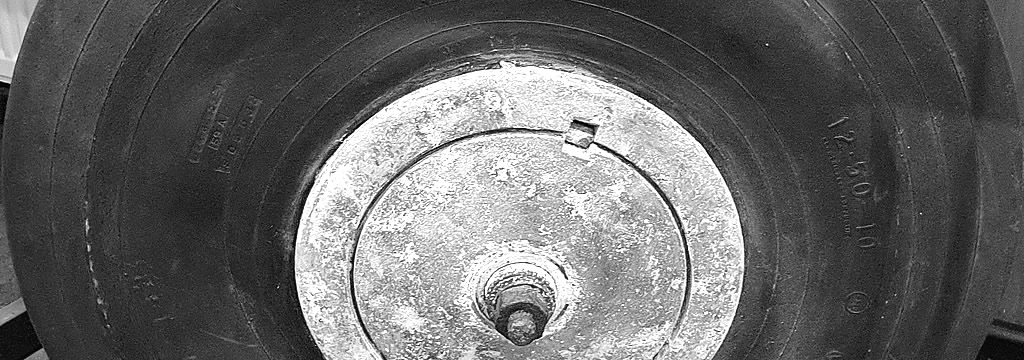Amazingly, pieces of the very first Lancaster to carry the JN-D code have survived.
75 (NZ) Squadron began the long-anticipated conversion from Short Stirling bombers to Avro Lancasters in March 1944.
In the first week of April, Sergeant Frank Scott RNZAF and his crew, having just completed their conversion course at Feltwell, were attached to nearby RAF Waterbeach for ten days, test-flying brand new Lancasters and delivering them to both 75 (NZ) Squadron at Mepal and 115 Squadron at Witchford.
On the 8th of April they flew a shiny new Lancaster across to Mepal, a Mark III, serial number ND802, which was allocated to “C” Flight and given the squadron code JN-D for “Dog”. The boys must have taken a fancy to her as she became their regular “kite”.
They gave her the nickname “The Flying Scottsmen”.

Front: Frank Scott (with temporary moustache), Ron Howson, Reg Dale.
– Jan Dodgson.
For some reason, none of the squadron’s Stirlings had ever been allocated the code JN-D, so Lancaster ND802 became the first JN-Dog.
Sadly, she would not last long.
By the time the Scott crew were detailed to attack Aachen on the night of 27/28th of May 1944 they had already flown six bombing operations in “The Flying Scottsmen” – this would be their seventh.
They took a newly-arrived Kiwi pilot with them as a “second dickie”, to gain operational experience. His name was Ron Clark. He had only been at Mepal for two days.
The F.A.J. Scott crew for that night was:
Sergeant Francis Alexander Jack “Frank” Scott, RNZAF NZ421105 – Pilot.
Warrant Officer Ronald Thomas Clark, RNZAF NZ422369 – 2nd Pilot.
Flight Sergeant Leslie George “Red” Hill, RNZAF NZ426997 – Navigator.
Flight Sergeant Stephen Astley Cook, RNZAF NZ421142 – Air Bomber.
Sergeant Ronald Edward Howson, RAFVR 1437112 – Wireless Operator.
Sergeant Frederick Maxwell “Max” Harris, RAFVR 1850150 – Flight Engineer.
Sergeant Alan Mantle, RAFVR 925315 – Mid Upper Gunner.
Sergeant Reginald Dale, RAFVR 1818763 – Rear Gunner.
The squadron supplied eighteen Lancasters and Frank was the tenth aircraft into the air, at fifteen minutes to one in the morning. He joined up with 160 other main force Lancasters circulating over eastern England before they all headed out towards the English Channel, crossing the coast at Southwold.
The bomber stream crossed the Channel and then the Dutch coast at Ouddorp, southwest of Rotterdam at the prescribed height of 20,000 feet and turning south-east across Holland towards the target.
About 20 minutes later, just after two o’clock in the morning, navigation lights were spotted by the Mid-Upper Gunner about 10,000 feet below. The aircraft, a German Ju 88 G-1 night fighter, turned off its lights and headed towards them. About three minutes later, it came up underneath the Lancaster, in the gunners’ blind spot, and fired two short bursts with its cannons. The interceptor was piloted by Luftwaffe Oberstleutnant Günther Radusch, the highly decorated commanding officer of the Nachtjägdgeschwader 2 night fighter wing, based at Deelen air force base in Holland. He had received his Iron Cross in person from Hitler only three weeks before.
Fire broke out mid-fuselage, and in the port wing and port-inner engine. Frank ordered the crew to bale out, while he tried to hold the aircraft steady, and six of the crew were able to jump before a fuel explosion blew the Lancaster apart in mid-air.
Frank and his Wireless Operator Ron Howson, were killed and the wreckage fell in a forest area near Gilze in the south of Holland. The other six safely parachuted, landing in the same forest, near Prinsenbosch Luftwaffe camp. Tragically, Bomb Aimer Stephen Cook was killed shortly after landing when the Lancaster’s bombs exploded on the ground. The other five, who had landed in different parts of the forest, headed off separately in the darkness, eventually to become PoWs.
The following day, the crash site was visited by local members of the Dutch underground who took photographs and “souvenired” several items from the wreckage. These included an envelope containing French and Belgian escape money and an escape map printed on fine silk, Lancaster landing and tail wheels, two .303 Browning machine guns from the rear turret and numerous .303 bullets, part of an incendiary bomb, instruments, and a propellor blade and hub (Constant Speed Unit housing).
Kept safe for the rest of the war, some of these items are now displayed in a small military museum at Gilze-Rijen Air Base, about 5 km from the crash site and these days home to the Royal Netherlands Air Force’s Defense Helicopter Command (DHC). The propellor blade was signed by crew member Alan Mantle on one of his visits to Holland in the 1970s.

– Henk Brul

Other items are said to have been taken back to New Zealand, but so far we have been unable to trace them.
It is hard to believe that such substantial pieces of the first JN-Dog have survived all these years, serving as a tribute not just to the courageous skipper and crew, but to the bravery and resourcefulness of the Dutch Underground.
The three crewmates killed in the crash, Frank Scott, Stephen Cook and Ron Howson, are buried together in the Gilze-en-Rijen Roman Catholic Cemetery (Gemenebest Rooms Katholieke Begraafplaats Gilze), Kerkstraat, Gilze.




